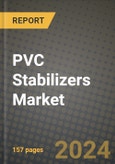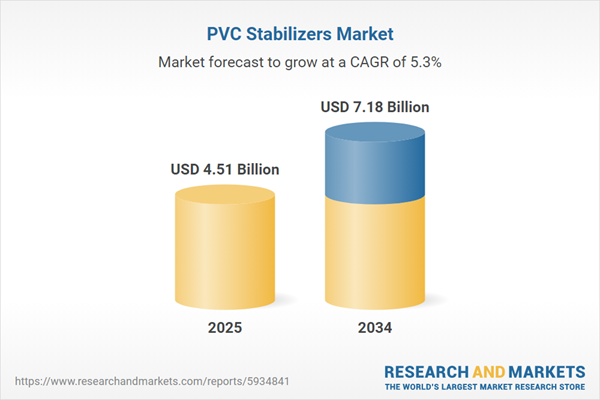PVC Stabilizers Market
The PVC stabilizers market supplies additive systems that prevent dehydrochlorination, color change, and viscosity drift during processing and service life across rigid and flexible PVC. Core applications include pressure and non-pressure pipes, window profiles and siding, cable & wire insulation, flooring, film/sheet, calendared leather, and injection-molded fittings. Product families span calcium-zinc (Ca-Zn), barium-zinc (Ba-Zn) for selected flexible uses, organotin (methyl/butyl tin) for high-clarity rigid articles and food-contact where permitted, mixed-metal soaps, hydrotalcite/metal-oxide systems, and emerging organic-based stabilizers (OBS) paired with co-stabilizers (ESBO, polyols, β-diketones) and internal/external lubricants. The strategic shift is from legacy lead systems to non-toxic, low-migration, low-odor packages that meet ROHS/REACH and regional food-contact codes while preserving processing windows on modern high-throughput extruders. Buyers seek “one-pack” formulations engineered to line conditions - screw design, shear/temperature profile, residence time - and to end-use stressors such as UV exposure, water chemistry, and electrical performance. Cable customers demand heat-ageing stability and low smoke/acid gas in LSZH formulations; building profiles prioritize long-term color hold and weatherability; pipe and fittings emphasize gloss, impact retention, and weld integrity. Sustainability pressures elevate recyclate compatibility, stabilizer efficiency at lower dosages, and traceable chemistries that support circular PVC streams without yellowing or gassing. Competitive differentiation rests on robust technical service (on-line trials, torque rheology, Congo-red/HCl evolution testing), consistent metal content, and secure sourcing of zinc salts, tin intermediates, and specialty co-stabilizers. As regulations tighten and converters raise line speeds, suppliers combining compliance-ready chemistries with application labs and regional logistics are best placed to win multi-year specifications.PVC Stabilizers Market Key Insights
- Regulatory-driven substitution accelerates Ca-Zn:
- Organotin retains high-clarity niches:
- Ba-Zn becomes selective and regional:
- One-pack engineering over single additives:
- Weatherable systems for building profiles:
- Pipe & fittings demand weld integrity:
- Cable & LSZH performance balance:
- Recycling and circularity compatibility:
- Supply security and metal volatility management:
- Data-rich technical service as a moat:
PVC Stabilizers Market Reginal Analysis
North America
Conversion to Ca-Zn is advanced in building products and non-pressure pipe, with organotin concentrated in clear rigid and CPVC applications. Buyers emphasize NSF/UL and electrical ratings, consistent early color, and weld strength. Supplier selection favors strong application labs, one-pack delivery, and logistics resilience. Recyclate-friendly packages gain traction in profiles and conduit as circularity targets rise.Europe
Strict REACH/ROHS frameworks and eco-labels accelerate non-lead, low-migration systems across profiles, cable, and flooring. Weatherable Ca-Zn with optimized TiO₂ interaction dominates outdoor profiles; OBS research expands for flexible goods. Documentation depth (DoC, NIAS, food-contact) and QUV correlation to field performance are decisive; stable EU manufacturing footprints and audited supply chains are preferred.Asia-Pacific
Largest volume base with significant new capacity in Ca-Zn and mixed-metal soaps. China and India continue transitions from lead in pipes/profiles, paced by local regulation and public procurement norms. High-speed extrusion lines require tailored one-packs; cable and footwear remain price sensitive but increasingly trial OBS/Ca-Zn to meet export specs. Local technical centers and rapid sampling win share.Middle East & Africa
Infrastructure and housing pipelines drive rigid PVC demand; stabilizer choice balances cost with potable-water and hot-climate performance. Regional production close to petro hubs supports supply reliability. Government tenders and utilities push gradual lead replacement; technical support for fusion/weld integrity under heat is a differentiator.South & Central America
Building cycles and utility programs anchor profiles and pipe demand. Currency volatility and freight costs elevate need for multi-grade flexibility and regional inventory. Non-lead adoption advances through export-oriented producers and retailers’ compliance playbooks; recyclate-compatible packages and simple, dust-free one-packs help smaller converters stabilize quality.PVC Stabilizers Market Segmentation
By Type
- Calcium-based
- Lead-based
- Tin-based
- Barium-based
- Others
By End-User
- Building and Construction
- Automotive
- Electrical and Electronics
- Packaging
- Footwear
- Others
Key Market players
ADEKA Corporation, Akdeniz Chemson, Baerlocher GmbH, SONGWON, Valtris Specialty Chemicals, Galata Chemicals, Reagens Group, Sun Ace Group, PMC Vinyl Additives (PMC Group), Pau Tai Industrial Corporation, Novista Group, Patcham FZC, Goldstab Organics, Vikas Ecotech Ltd., Platinum Industries Ltd.PVC Stabilizers Market Analytics
The report employs rigorous tools, including Porter’s Five Forces, value chain mapping, and scenario-based modelling, to assess supply-demand dynamics. Cross-sector influences from parent, derived, and substitute markets are evaluated to identify risks and opportunities. Trade and pricing analytics provide an up-to-date view of international flows, including leading exporters, importers, and regional price trends.Macroeconomic indicators, policy frameworks such as carbon pricing and energy security strategies, and evolving consumer behaviour are considered in forecasting scenarios. Recent deal flows, partnerships, and technology innovations are incorporated to assess their impact on future market performance.
PVC Stabilizers Market Competitive Intelligence
The competitive landscape is mapped through proprietary frameworks, profiling leading companies with details on business models, product portfolios, financial performance, and strategic initiatives. Key developments such as mergers & acquisitions, technology collaborations, investment inflows, and regional expansions are analyzed for their competitive impact. The report also identifies emerging players and innovative startups contributing to market disruption.Regional insights highlight the most promising investment destinations, regulatory landscapes, and evolving partnerships across energy and industrial corridors.
Countries Covered
- North America - PVC Stabilizers market data and outlook to 2034
- United States
- Canada
- Mexico
- Europe - PVC Stabilizers market data and outlook to 2034
- Germany
- United Kingdom
- France
- Italy
- Spain
- BeNeLux
- Russia
- Sweden
- Asia-Pacific - PVC Stabilizers market data and outlook to 2034
- China
- Japan
- India
- South Korea
- Australia
- Indonesia
- Malaysia
- Vietnam
- Middle East and Africa - PVC Stabilizers market data and outlook to 2034
- Saudi Arabia
- South Africa
- Iran
- UAE
- Egypt
- South and Central America - PVC Stabilizers market data and outlook to 2034
- Brazil
- Argentina
- Chile
- Peru
Research Methodology
This study combines primary inputs from industry experts across the PVC Stabilizers value chain with secondary data from associations, government publications, trade databases, and company disclosures. Proprietary modeling techniques, including data triangulation, statistical correlation, and scenario planning, are applied to deliver reliable market sizing and forecasting.Key Questions Addressed
- What is the current and forecast market size of the PVC Stabilizers industry at global, regional, and country levels?
- Which types, applications, and technologies present the highest growth potential?
- How are supply chains adapting to geopolitical and economic shocks?
- What role do policy frameworks, trade flows, and sustainability targets play in shaping demand?
- Who are the leading players, and how are their strategies evolving in the face of global uncertainty?
- Which regional “hotspots” and customer segments will outpace the market, and what go-to-market and partnership models best support entry and expansion?
- Where are the most investable opportunities - across technology roadmaps, sustainability-linked innovation, and M&A - and what is the best segment to invest over the next 3-5 years?
Your Key Takeaways from the PVC Stabilizers Market Report
- Global PVC Stabilizers market size and growth projections (CAGR), 2024-2034
- Impact of Russia-Ukraine, Israel-Palestine, and Hamas conflicts on PVC Stabilizers trade, costs, and supply chains
- PVC Stabilizers market size, share, and outlook across 5 regions and 27 countries, 2023-2034
- PVC Stabilizers market size, CAGR, and market share of key products, applications, and end-user verticals, 2023-2034
- Short- and long-term PVC Stabilizers market trends, drivers, restraints, and opportunities
- Porter’s Five Forces analysis, technological developments, and PVC Stabilizers supply chain analysis
- PVC Stabilizers trade analysis, PVC Stabilizers market price analysis, and PVC Stabilizers supply/demand dynamics
- Profiles of 5 leading companies - overview, key strategies, financials, and products
- Latest PVC Stabilizers market news and developments
Additional Support
With the purchase of this report, you will receive:- An updated PDF report and an MS Excel data workbook containing all market tables and figures for easy analysis.
- 7-day post-sale analyst support for clarifications and in-scope supplementary data, ensuring the deliverable aligns precisely with your requirements.
- Complimentary report update to incorporate the latest available data and the impact of recent market developments.
This product will be delivered within 1-3 business days.
Table of Contents
Companies Mentioned
- ADEKA Corporation
- Akdeniz Chemson
- Baerlocher GmbH
- SONGWON
- Valtris Specialty Chemicals
- Galata Chemicals
- Reagens Group
- Sun Ace Group
- PMC Vinyl Additives (PMC Group)
- Pau Tai Industrial Corporation
- Novista Group
- Patcham FZC
- Goldstab Organics
- Vikas Ecotech Ltd.
- Platinum Industries Ltd.
Table Information
| Report Attribute | Details |
|---|---|
| No. of Pages | 160 |
| Published | November 2025 |
| Forecast Period | 2025 - 2034 |
| Estimated Market Value ( USD | $ 4.51 Billion |
| Forecasted Market Value ( USD | $ 7.18 Billion |
| Compound Annual Growth Rate | 5.3% |
| Regions Covered | Global |
| No. of Companies Mentioned | 15 |









